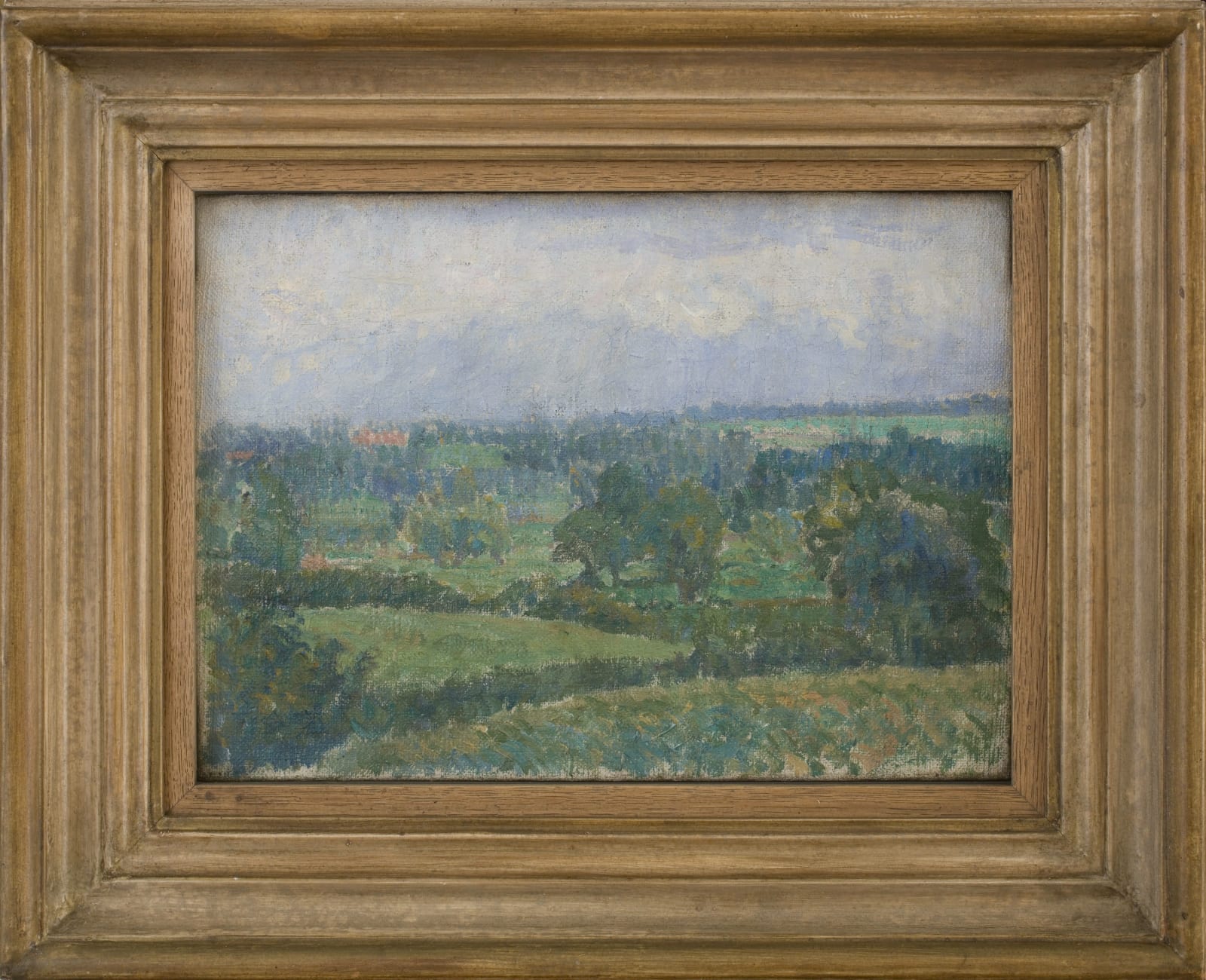Spencer Gore
Country Landscape, 1909-10, c.
Oil on canvas
25.8 x 35.8 cm
10 1/8 x 14 1/8 in
10 1/8 x 14 1/8 in
Copyright The Artist
This work depicts a characteristic scene in the English tradition of bucolic landscape painting. A haze of blue-grey summer cloud hangs over a patchwork of verdant fields, hedgerows and trees....
This work depicts a characteristic scene in the English tradition of bucolic landscape painting. A haze of blue-grey summer cloud hangs over a patchwork of verdant fields, hedgerows and trees. The terracotta roof of a farm building is visible on the horizon in the distance. Owing to its diminutive size and the freedom with which it was executed, it was perhaps executed on the spot en plein air. (Gore started his career by exhibiting with the New English Art Club and would have learned this practice from his fellow exhibitor Lucien Pissarro.)
It is unclear where Gore painted this work or the county it depicts. He spent time at Applehayes Farm in Clayhidon, Devon, and spent many summers in Hertingfordbury, Hertfordshire, where his mother lived. Though it was at one time known as Sussex Landscape, this painting is most likely to have been painted in Yorkshire or Somerset, where Gore also worked. Comparable works to use elevated vantage points, hazy summer cloud and a densely worked surface include An Extensive Landscape in Yorkshire (circa 1907, Yale Center for British Art) and Somerset Landscape (circa 1909, University of Hull Art Collection). Country Landscape is undoubtedly closer in mood and palette to the latter (fig. 1).
Gore played a significant role in avant-garde British art up until his premature death in 1914. From Pissarro, whose father Camille was one of the originators of Impressionism, Gore grasped two fundamental principles in painting: add paint in broken touches; and use full colour (not relative areas of light and dark) to represent the subject. The approach adopted by Pissarro and Gore was influential, with Walter Sickert remarking in 1911 that he only started to ‘observe colour in the shadows’ following their example. Though Gore later progressed to a more gestural style of painting akin to that of the ‘Post-Impressionist’ artists selected by Roger Fry at the Grafton Galleries in 1910 and 1912, Country Landscape exemplifies his earlier Impressionistic phase. The evocation of form using loose groupings of broken brushstrokes is typical for his work of the period.
Wendy Baron has noted that ‘the absence of a studio stamp suggests that the present work was sold in the artist's lifetime.’ Country Landscape was previously in the collection of Mattei Radev (1927–2009), a Bulgarian émigré who came to Britain in 1950. He forged an intimate acquaintance with certain circles of the Bloomsbury Group; his obituarist described him, following the death of Frances Partridge, as ‘a vestige of Bloomsbury’. Radev possessed many significant works of twentieth-century British art. His collection included paintings by Bloomsbury artists like Vanessa Bell, Duncan Grant, and Eardley Knollys; Neo-Romantics like Piper and Sutherland; and other distinguished names such as John Armstrong, Ivon Hitchens, Frances Hodgkins and Ben Nicholson.
It is unclear where Gore painted this work or the county it depicts. He spent time at Applehayes Farm in Clayhidon, Devon, and spent many summers in Hertingfordbury, Hertfordshire, where his mother lived. Though it was at one time known as Sussex Landscape, this painting is most likely to have been painted in Yorkshire or Somerset, where Gore also worked. Comparable works to use elevated vantage points, hazy summer cloud and a densely worked surface include An Extensive Landscape in Yorkshire (circa 1907, Yale Center for British Art) and Somerset Landscape (circa 1909, University of Hull Art Collection). Country Landscape is undoubtedly closer in mood and palette to the latter (fig. 1).
Gore played a significant role in avant-garde British art up until his premature death in 1914. From Pissarro, whose father Camille was one of the originators of Impressionism, Gore grasped two fundamental principles in painting: add paint in broken touches; and use full colour (not relative areas of light and dark) to represent the subject. The approach adopted by Pissarro and Gore was influential, with Walter Sickert remarking in 1911 that he only started to ‘observe colour in the shadows’ following their example. Though Gore later progressed to a more gestural style of painting akin to that of the ‘Post-Impressionist’ artists selected by Roger Fry at the Grafton Galleries in 1910 and 1912, Country Landscape exemplifies his earlier Impressionistic phase. The evocation of form using loose groupings of broken brushstrokes is typical for his work of the period.
Wendy Baron has noted that ‘the absence of a studio stamp suggests that the present work was sold in the artist's lifetime.’ Country Landscape was previously in the collection of Mattei Radev (1927–2009), a Bulgarian émigré who came to Britain in 1950. He forged an intimate acquaintance with certain circles of the Bloomsbury Group; his obituarist described him, following the death of Frances Partridge, as ‘a vestige of Bloomsbury’. Radev possessed many significant works of twentieth-century British art. His collection included paintings by Bloomsbury artists like Vanessa Bell, Duncan Grant, and Eardley Knollys; Neo-Romantics like Piper and Sutherland; and other distinguished names such as John Armstrong, Ivon Hitchens, Frances Hodgkins and Ben Nicholson.
Provenance
With Rutland Gallery, London (listed as 'Sussex landscape')Mattei Radev
Private Collection, UK, by descent
